
The Arctiinae are a large and diverse subfamily of moths with around 11,000 species found all over the world, including 6,000 neotropical species. This subfamily includes the groups commonly known as tiger moths, which usually have bright colours, footmen, which are usually much drabber, lichen moths, and wasp moths. Many species have "hairy" caterpillars that are popularly known as woolly bears or woolly worms. The scientific name Arctiinae refers to this hairiness. Some species within the Arctiinae have the word "tussock"' in their common names because they have been misidentified as members of the Lymantriinae subfamily based on the characteristics of the larvae.

Alpheus Spring Packard Jr. LL.D. was an American entomologist and palaeontologist. He described over 500 new animal species – especially butterflies and moths – and was one of the founders of The American Naturalist.

Dryocampa rubicunda, the rosy maple moth, is a small North American moth in the family Saturniidae, also known as the great silk moths. It was first described by Johan Christian Fabricius in 1793. The species is known for its wooly body and pink and yellow coloration, which varies from cream or white to bright pink or yellow. Males have bushier antennae than females, which allow them to sense female pheromones for mating.
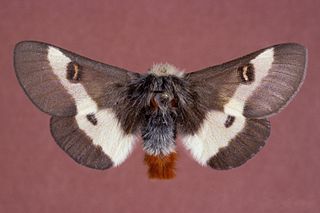
The buck moth is a common insect found in oak forests, stretching in the United States from peninsular Florida to New England, and as far west as Texas and Kansas. It was first described by Dru Drury in 1773. The larvae typically emerge in a single generation in the spring. The larvae are covered in hollow spines that are attached to a poison sac. The poison can cause symptoms ranging from stinging, itching and burning sensations to nausea. Subspecies Hemileuca maia maia is listed as endangered in the US state of Connecticut.
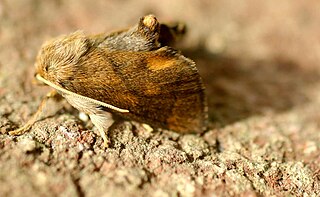
The Limacodidae or Eucleidae are a family of moths in the superfamily Zygaenoidea or the Cossoidea; the placement is in dispute. They are often called slug moths because their caterpillars bear a distinct resemblance to slugs. They are also called cup moths because of the shape of their cocoons.

The spiny oak slug is the larval form (caterpillar) of a moth in the family Limacodidae.

The saddleback caterpillar is the larva of a species of moth native to eastern North America. It is also found in Mexico. The species belongs to the family of slug caterpillars, Limacodidae.

Estigmene acrea, the salt marsh moth or acrea moth, is a moth in the family Erebidae. The species was first described by Dru Drury in 1773. It is found in North America, and southwards from Mexico to Colombia.
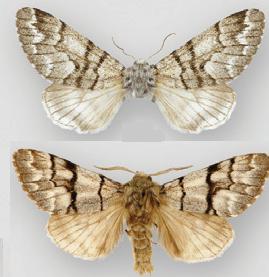
Panthea furcilla is a species of moth of the family Noctuidae. It is found across the boreal forest region of Canada west to the Rocky Mountains, and in the eastern parts of the United States, from Maine to Florida, west to Texas, north to Indiana and Ohio.

Abagrotis alternata, the greater red dart or mottled gray cutworm, is a moth of the family Noctuidae. The species was first described by Augustus Radcliffe Grote in 1865. It is found in eastern North America, from New Brunswick west across southern Canada to western Alberta, south to Arizona, New Mexico and the Gulf of Mexico.

Lophocampa maculata, the Yellow-spotted tussock moth, mottled tiger or spotted halisidota, is a moth of the family Erebidae and the tribe Arctiini, the tiger moths. The species was first described by Thaddeus William Harris in 1841. It is found across Canada, the western parts of the United States, south in the Appalachians to South Carolina and Kentucky. They are also found in Southeastern Alaska.
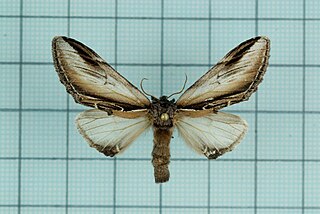
Pheosia rimosa, the black-rimmed prominent moth, fissured prominent or false-sphinx, is a moth of the family Notodontidae. The species was first described by Alpheus Spring Packard in 1864. It is found from coast to coast in North America, although it is less common in the south-eastern United States.

Synchlora aerata, the wavy-lined emerald moth or camouflaged looper, is a species of moth of the family Geometridae. The species was described by Johan Christian Fabricius in 1798. It is found in the United States and Canada.
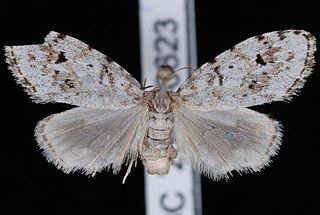
Clemensia albata, the little white lichen moth, is a moth of the family Erebidae. It was described by Alpheus Spring Packard in 1864. It is found in eastern North America, west across boreal Canada to south-eastern British Columbia. The range extends along the Pacific Coast south to Monterey Bay in west-central California. The habitat consists of moist forests, including coastal rainforests, oak woodlands and mixed hardwood forests.

Packardia is a genus of moths in the family Limacodidae.
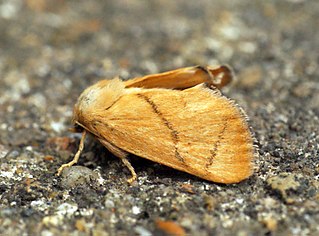
Apoda is a genus of slug caterpillar moths in the family Limacodidae. There are about 10 described species in Apoda.

Lithacodes gracea, the graceful slug moth, is a species of slug caterpillar moth in the family Limacodidae.

Lithacodes is a genus of slug caterpillar moths in the family Limacodidae. There are about five described species in Lithacodes.

Emily L. Morton was an American entomologist and scientific illustrator. She was a co-author at onset of The Life-Histories of the New York Slug Caterpillars series.
















